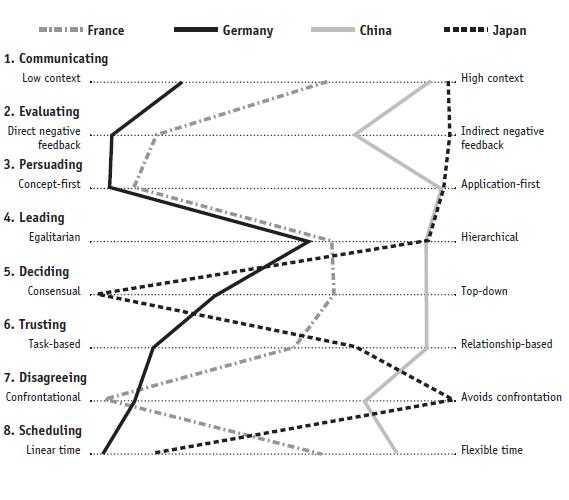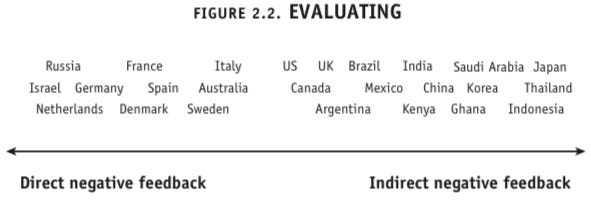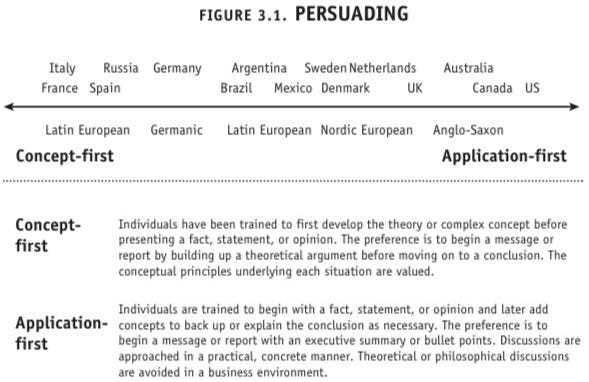Emma 's Key Ideas from The Culture Map
by Erin Meyer
Ideas, facts & insights covering these topics:
11 ideas
·18.5K reads
82
1
Explore the World's Best Ideas
Join today and uncover 100+ curated journeys from 50+ topics. Unlock access to our mobile app with extensive features.
“The way we are conditioned to see the world in our own culture seems so completely obvious and commonplace that it is difficult to image that another culture might do things differently. It is only when you start to identify what is typical in your culture but different from others, that you can begin to open a dialogue of sharing, learning, and ultimately understanding.”
ERIN MEYER
199
4.29K reads
The invisible boundaries that divide our world
The majority of managers who conduct business internationally have little understanding of how culture is impacting their work. This is especially true as more and more of us communicate daily with people in other countries over virtual media.
When you live extensively in a foreign country, you pick up a lot of contextual cues that help you understand the culture of the people living there, and you decode communication and adapt accordingly. But when you exchange emails with an international counterpart in a country you haven’t spent time in, it is much easier to miss the cultural subtleties impacting the communication.
172
1.33K reads
“Leaders have always needed to understand human nature and personality differences to be successful in business--that's nothing new. What's new is the requirement for twenty-first century leaders to be prepared to understand a wider, richer array of work styles than ever before and to be able to determine what aspects of an interaction are simply a result of personality and which are a result of differences in cultural perspective.”
ERIN MEYER
178
1.08K reads
How we understand each other
Cultural patterns of behavior and belief frequently impact our perceptions (what we see), cognitions (what we think), and actions (what we do).
Many of the cultural differences—varying attitudes concerning when best to speak or stay quiet, the role of the leader in the room, and what kind of negative feedback is the most constructive—may seem small.
But if you are unaware of the differences and unarmed with strategies for managing them effectively, they can derail your team meetings, demotivate your employees, frustrate your foreign suppliers, and in dozens of other ways make it much more difficult to achieve your goals
175
891 reads
When having an open mind is not enough
It is common, to work across cultures for decades and travel frequently for business while remaining unaware and uninformed about how culture impacts you. Millions of people work in global settings while viewing everything from their own cultural perspectives and assuming that all differences, controversy, and misunderstanding are rooted in personality.
This is not due to laziness. Many well-intentioned people don’t educate themselves about cultural differences because they believe that if they focus on individual differences, that will be enough.
172
796 reads
Eight scales that map the world's cultures
Each of the eight scales represents one key area that managers must be aware of, showing how cultures vary along a spectrum from one extreme to its opposite. The eight scales are:
- Communicating: low-context vs. high-context
- Evaluating: direct negative feedback vs. indirect negative feedback
- Persuading: principles-first vs. applications-first
- Leading: egalitarian vs. hierarchical
- Deciding: consensual vs. top-down
- Trusting: task-based vs. relationship-based
- Disagreeing: confrontational vs. avoids confrontation
- Scheduling: linear-time vs. flexible-time.
198
804 reads
Communicating: low-context vs high-context
- In cultures where low-context communication styles are prevalent, people assume a low level of shared context — few shared reference points and comparatively little implicit knowledge linking speaker and listener. In low-context countries like the United States and the Netherlands, effective communication must be simple, clear, and explicit in order to effectively pass the message.
- In contrast, in high-context countries such as the United Kingdom and Japan, people tend to communicate in ways that are implicit and rely heavily on shared context. Someone from a high-context culture might accuse a low-context speaker of being too direct, whereas a low-context listener might often wonder if the high-context speaker will ever get to the point.
182
629 reads
Evaluating: direct negative feedback vs indirect negative feedback
Erin Meyer’s Evaluating scale offers insights into how to give effective performance appraisals and negative feedback in different parts of the world. The spectrum goes from “direct negative feedback” to “indirect negative feedback”.
With direct negative feedback, the feedback is delivered to a colleague frankly, bluntly and honestly. Negative messages stand alone, not softened by positive ones. In contrast, when indirect negative feedback is provided it’s done in a soft, subtle and diplomatic manner.
172
614 reads
How to provide feedback
- When providing an evaluation, be explicit and low-context with both positive and negative feedback. Don't launch into the negative until you’ve also explicitly stated something that you appreciate about the person or the situation. The positive comments should be honest and stated in a detailed, explicit manner.
- Try, over time, to be balanced in the amount of positive and negative feedback you give.
- Frame your behavior in cultural terms. Don’t use your cultural background as an excuse to be disrespectful but talk openly about the cultural differences that explain your communication style.
170
524 reads
Persuading: principles-first vs applications-first
There are two types of reasoning we can use to persuade:
- Principles-first (or deductive) reasoning derives conclusions or facts from general principles or concepts. People from principles-first cultures generally want to understand the why behind their boss’s request before they move to action
- With applications-first reasoning (or inductive) reasoning, general conclusions are based on a pattern of factual observations from the real world. Applications-first learners tend to focus less on the why and more on the how.
180
560 reads
When interacting with someone from another culture, try to watch more, listen more, and speak less.
ERIN MEYER
197
6.98K reads
IDEAS CURATED BY
Curious about different takes? Check out our The Culture Map Summary book page to explore multiple unique summaries written by Deepstash users.
Emma 's ideas are part of this journey:
Learn more about communication with this collection
How to prioritize tasks effectively
How to manage your time efficiently
How to reduce stress and anxiety
Related collections
Different Perspectives Curated by Others from The Culture Map
Curious about different takes? Check out our book page to explore multiple unique summaries written by Deepstash curators:
1 idea
Quotes 's Key Ideas from The Culture Map
Erin Meyer
1 idea
's Key Ideas from The Culture Map
Erin Meyer
18 ideas
Discover Key Ideas from Books on Similar Topics
10 ideas
Becoming a Changemaker
Alex Budak
20 ideas
12 Rules for Life
Jordan B. Peterson
40 ideas
12 Rules for Life
Jordan B. Peterson
Read & Learn
20x Faster
without
deepstash
with
deepstash
with
deepstash
Personalized microlearning
—
100+ Learning Journeys
—
Access to 200,000+ ideas
—
Access to the mobile app
—
Unlimited idea saving
—
—
Unlimited history
—
—
Unlimited listening to ideas
—
—
Downloading & offline access
—
—
Supercharge your mind with one idea per day
Enter your email and spend 1 minute every day to learn something new.
I agree to receive email updates



